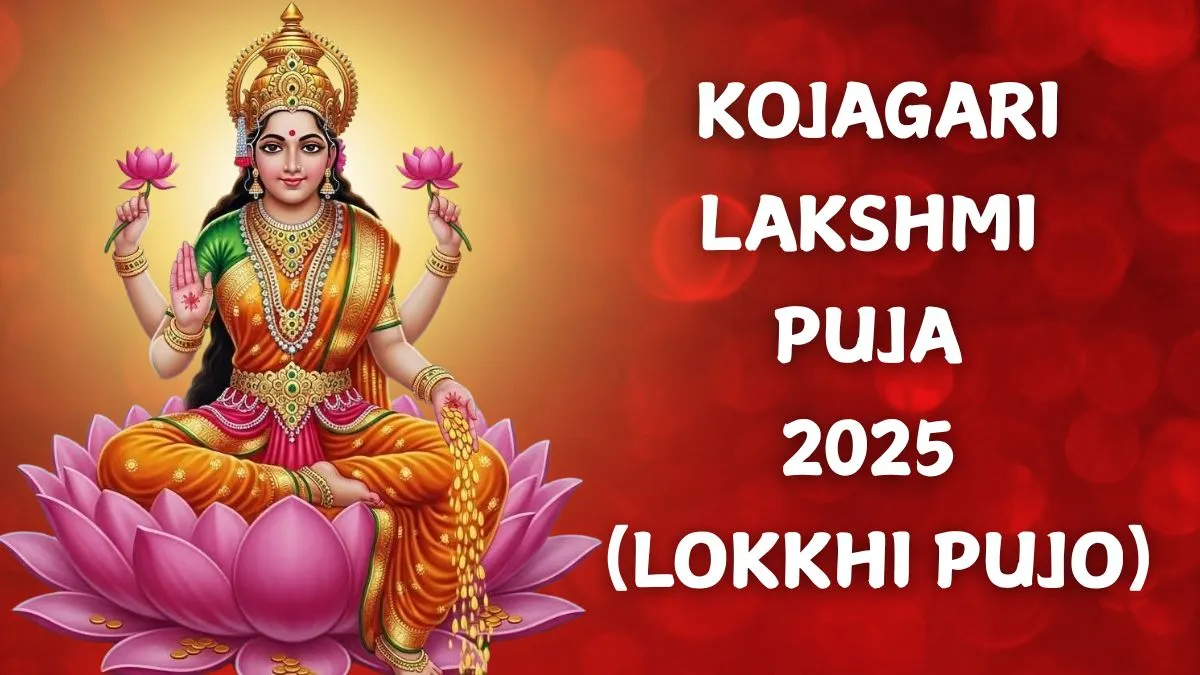- By Kashish Rai
- Sun, 05 Oct 2025 01:17 PM (IST)
- Source:JND
Bengali Lakshmi Puja 2025: Unlike much of India, Bengal celebrates Lakshmi Puja not during Diwali but shortly after Durga Puja. Known as Kojagori Lakshmi Puja, this festival typically occurs within a week of Durga Puja’s conclusion. It falls on the full moon of Ashwin, also called Kojagori Purnima, just days after Maa Durga’s departure. On this auspicious night, it is believed that Goddess Lakshmi visits homes, bestowing prosperity, wealth, and happiness upon devotees. Widely celebrated across Bengal, this revered occasion is also referred to as Lokkhi Pujo. This year, Kojagari Laxmi Puja or Lokkhi Pujo will be observed on 6th October 2025.
Check out all the significant details about the date, timings, shubh muhurat, significance and rituals of Kojagari Laxmi Puja or Lokkhi Pujo below:
Bengali Lakshmi Puja 2025: Date And Time
- Bengali Lakshmi Puja 2025 Date: 6th October 2025, Monday
- Purnima Tithi Begins: 12:23 PM on October 06, 2025
- Purnima Tithi Ends: 09:16 AM on October 07, 2025
- Moonrise Time: 05:26 PM
Bengali Lakshmi Puja 2025: Shubh Muhurat
The Nishita Puja muhurat to worship Goddess Lakshmi on Kojagari Laxmi Puja is from 11:45 PM to 12:34 AM, 7th October 2025.
Bengali Lakshmi Puja 2025: Significance
Kojagara Vrat or Kojagari Laxmi Puja is a significant festival celebrated across West Bengal, Odisha, and Assam, dedicated to the worship of Goddess Lakshmi. Observed on the full moon of Ashwin, this fast is unique for the tradition of keeping vigil, or Jagarana, throughout the night. According to legend, Goddess Lakshmi visits the world on this night, bestowing wealth, prosperity, and happiness upon devoted worshippers who remain awake. Known also as Kojagari Puja, Bengali Lakshmi Puja, or Kaumudi Vrat, this observance is deeply rooted in spiritual belief. Devotees perform rituals, offer prayers and engage in devotional activities, seeking blessings for a prosperous and fulfilling life.
ALSO READ: Kojagiri Purnima 2025: Date, Time, Shubh Muhurat, Significance And Rituals

Kojagari Lakshmi Puja, celebrated after Durga Puja, honours Goddess Lakshmi, bringing prosperity, wealth, and happiness to homes in Bengal. (Image Source: Canva)
The importance of Kojagara Vrat is described by sage Valakhilya in sacred texts. He explained that worshipping Goddess Lakshmi on Shuklapaksha Purnima of Ashwin, with devotion and night-long vigil, pleases the goddess immensely. On this night, she is said to enjoy offerings such as coconut water and the traditional game of Chausar. Devotees practising Jagarana are believed to receive her boons, attracting wealth, health, and happiness. Even those facing poverty can transform their fortunes by observing this fast, as illustrated by the story of Valit, a poor Brahmin who attained prosperity through Kojagara Vrat, highlighting its enduring spiritual and cultural significance.
Bengali Lakshmi Puja 2025: Rituals
Kojagari Lakshmi Puja is a deeply cherished festival in Bengali households, celebrated with devotion and joy. Preparations begin early in the day, creating an atmosphere of anticipation and reverence. The main puja rituals, however, take place in the evening, as families gather to welcome Goddess Lakshmi. Every step, from cleaning the home to decorating the puja area, is performed with care, reflecting the belief that the goddess only blesses pure and organised spaces.
An essential part of the celebration is creating Alpana, the traditional white and red designs made with rice paste. These intricate patterns are drawn at the entrance and around the puja area, often featuring tiny footprints symbolising the goddess’s arrival. A beautifully decorated Lakshmi Puja thali is prepared, including flowers, fruits, a diya, and lotus flowers, sacred to Maa Lakshmi. The thali is used during the aarti, followed by offering prasad such as sweets, coconut laddu, halwa puri, khichdi, and payesh.
Another key aspect of Kojagari Lakshmi Puja is the puja katha and jagarana. Families gather to recite or listen to the vrat katha, sharing stories of devotion and the blessings that Maa Lakshmi bestows upon her devotees. The jagarana, or night-long vigil, is observed with singing, lighting diyas, and prayer. Staying awake through the night is believed to invite the goddess’s presence, ensuring prosperity, happiness, and divine blessings for the entire household.
(Disclaimer: This content includes advice providing generic information only. It is in no way a substitute for qualified spiritual or astrological opinion. Always consult a specialist for more information before adopting any measures.)

